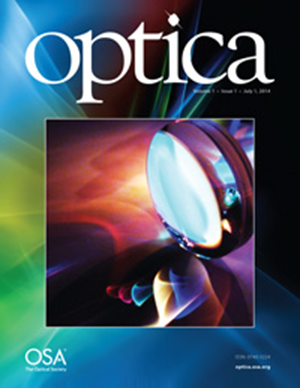通过布里渊谐振器的差分频率进行超低噪声微波合成
IF 8.4
1区 物理与天体物理
Q1 OPTICS
引用次数: 0
摘要
低相位噪声微波振荡器是光子学和电子学领域众多应用的核心。在这一领域,微波频率合成的光学衍生方法尤为引人注目,因为它们将超宽带频率接入和通过共模噪声抑制来抵御温度和环境扰动的潜力独特地结合在一起。我们在此展示了一种光学分频器,它利用两个受激布里渊散射(SBS)激光器之间的 30 太赫兹频率间隙作为分频的基础。由此产生的微波信号以 10 GHz 频率为中心,在 10 Hz 和 100 Hz 频率偏移时分别表现出-95dBc/Hz{-}{95}\;{\rm dBc/Hz}和-110dBc/Hz{-}{110}\;{\rm dBc/Hz}的超低相位噪声水平。此外,这两个 SBS 激光器由一个共用光纤谐振器产生,在它们的频率差中表现出高度的相关噪声抵消。我们测得 16.1 dB 的噪声抑制能力可抵御有意施加的振动,从而为实现便携式、坚固耐用的超低噪声光子微波合成提供了一条大有可为的途径。本文章由计算机程序翻译,如有差异,请以英文原文为准。
Ultralow noise microwave synthesis via difference frequency division of a Brillouin resonator
Low phase noise microwave oscillators are at the center of a multitude of applications that span the gamut of photonics and electronics. Within this space, optically derived approaches to microwave frequency synthesis are particularly compelling owing to their unique combination of ultrawideband frequency access and the potential for resiliency to temperature and environmental perturbation via common-mode noise rejection. We demonstrate here an optical frequency divider that uses the 30 terahertz frequency gap between two stimulated Brillouin scattering (SBS) lasers as the basis for frequency division. The resulting microwave signal, centered at 10 GHz frequency, exhibits exceptionally low phase noise levels of −95dBc/Hz and −110dBc/Hz at 10 Hz and 100 Hz frequency offset, respectively. Moreover, the two SBS lasers, generated from a common fiber resonator, exhibit a high degree of correlated noise cancellation in their frequency difference. We measure 16.1 dB of noise rejection against intentionally applied vibrations, thus showcasing a promising pathway towards portable and robust ultralow noise photonic-microwave synthesis.
求助全文
通过发布文献求助,成功后即可免费获取论文全文。
去求助
来源期刊

Optica
OPTICS-
CiteScore
19.70
自引率
2.90%
发文量
191
审稿时长
2 months
期刊介绍:
Optica is an open access, online-only journal published monthly by Optica Publishing Group. It is dedicated to the rapid dissemination of high-impact peer-reviewed research in the field of optics and photonics. The journal provides a forum for theoretical or experimental, fundamental or applied research to be swiftly accessed by the international community. Optica is abstracted and indexed in Chemical Abstracts Service, Current Contents/Physical, Chemical & Earth Sciences, and Science Citation Index Expanded.
 求助内容:
求助内容: 应助结果提醒方式:
应助结果提醒方式:


